LARES-2 (Laser Relativity Satellite-2)
EO
Gravity and Magnetic Fields
Gravity, Magnetic and Geodynamic measurements
Operational (nominal)
Quick facts
Overview
| Mission type | EO |
| Agency | ASI |
| Mission status | Operational (nominal) |
| Launch date | 13 Jul 2022 |
| Measurement domain | Gravity and Magnetic Fields |
| Measurement category | Gravity, Magnetic and Geodynamic measurements |
| Measurement detailed | Gravity field, Crustal Motion, Gravity gradients, Crustal plates positioning |
| Instruments | LCCRA (LARES-2) |
| Instrument type | Precision orbit |
| CEOS EO Handbook | See LARES-2 (Laser Relativity Satellite-2) summary |
LARES-2 (Laser Relativity Satellite-2)
LARES 2 is a satellite, carrying only a laser retroreflector array (LRA), developed by the Italian Space Agency (ASI), approved for a launch in early 2020, on the new ESA launcher VEGA-C. The launcher is an enhanced version of VEGA that can place the payload/satellite in a much higher orbit than the 1450 km, which was the case with the LARES launch in 2012. 1)
The laser-ranging technique and an extremely precise knowledge of the Earth gravitational field paved the way to perform very accurate measurements in General Relativity and Earth science using passive satellites. LARES-2 belongs to this category of satellites and is approved by the Italian Space Agency. One of the most interesting effects predicted by General Relativity is frame-dragging according to which the inertial reference frames are dragged by currents of mass-energy, such as a rotating mass. Indeed, the Earth rotation produces this effect that has already been measured by a very accurate orbit determination of the LAGEOS and LARES satellites. With this new satellite it will be possible to improve the accuracy of the measurement by one order of magnitude. This very demanding objective can be reached thanks to the unique orbit and the special design of the LARES-2 satellite. 2)
Fundamental physics with LARES-2 mission: The LARES-2 space experiment is aimed at testing General Relativity with unprecedented accuracy . 3) In particular it will measure the intriguing phenomenon of frame-dragging with an accuracy of approximately 2 x 10-3. Today the best tests of frame-dragging reach 2% accuracy using the LARES (ASI, 2012), LAGEOS (NASA, 1976) and LAGEOS-2 (ASI and NASA, 1992) satellites. 4) Frame-dragging is the dragging of the axes of the local inertial frames determined by test-gyroscopes.
The gyroscopes are dragged in General Relativity by the currents of mass-energy in a way formally similar in electrodynamics to the Larmor precession of a magnetic dipole by the electric currents. For this weak-field and slow-motion analogy, frame-dragging is sometimes called gravitomagnetism. Some interesting alternative gravitational theories, which may explain the riddle of dark energy and quintessence (and the observed accelerated expansion of the universe), predict a different outcome than General Relativity for frame-dragging. LARES-2 will allow other tests of fundamental physics and General Relativity, such as the test of the equivalence principle with unprecedented accuracy at the range of about 12,270 km. Today the best test of the equivalence principle at a range of 12,270 has an accuracy of about 10-9 and was obtained using LARES, LAGEOS and LAGEOS 2 satellites. 5)
Space geodesy with LARES and LARES- 2: There are several missions in orbit carrying retroreflector arrays used as laser ranging targets for precise orbit determination. However, only a few of them are designed for high precision applications in space geodesy. These ones are characterized by the spherical shape of the "bus" and the high density of the material they are made of, which provide the satellite with an optimal surface-to-mass ratio. LARES has the lowest such ratio and consequently it is an important target for the SLR (Satellite Laser Ranging) technique. Increasing the number of such satellites in orbit will improve the quality of the products derived from SLR data, that primarily contribute to the ITRF (International Terrestrial Reference Frame), to the estimation of low-degree harmonics of the Earth's gravitational field and the EOP (Earth Orientation Parameters), polar motion (i.e the Earth rotation axis direction) and the LOD (Length of Day). The other techniques used in combination with SLR that contribute to the determination of the EOP are the VLBI (Very Long Baseline Interferometry) and GNSS (Global Navigation Satellite System).
Another technique, more recent than the others is the DORIS (Doppler Orbitography and Radiopositioning Integrated by Satellites). The determination of the center of mass of the Earth is only obtained from SLR. This can be intuitively understood since the center of mass of Earth is the focus of the orbit of the satellites that can be assumed as first approximation as an ellipse. Of all satellite techniques, SLR is at present the only one that can sense the center of mass at sub-mm accuracy and monthly resolution. On the other hand, the most important technique for polar motion determination is GNSS. The determination of the inertial direction of the Earth rotation vector is a sole product of VLBI; this can be intuitively understood since the rotation axis is referenced by VLBI with respect to distant quasars. The accuracy required today in space geodesy is comparable to what is required in fundamental physics, if not even more demanding. In fact, the ILRS (International Laser Ranging Service) required that the design for the new LARES-2 mission be such that the target signature error remains at the 1 mm level.
The improvement which will result from the incorporation of LARES in the constellation of geodetic laser ranged satellites was quantified in. 6) In that paper it is shown that an improvement in the position of the SLR stations of about 20% with a standard deviation improvement of about 11% is expected. The improvement in the polar motion components will be in the order of 24% in the x-component with a standard deviation improvement of 8.2% and 18.7% in the y-component with a standard deviation improvement of 6.9%; the improvement expected in the LOD is about 19.8% with a standard deviation improvement of 7.4%. With the addition of LARES 2 to the geodetic constellation further improvements are expected in geodetic parameters (e.g. gravitational field harmonics, tides, etc.). 7) 8) 9)
Spacecraft
LARES-2 is a passive satellite that relies only on the CCR (Cube Corner Reflector) array to realize its precise orbit. The ILRS (International Laser Ranging Service) will provide tracking to the satellite with its laser stations (more than 40 worldwide at present) that will allow the orbit reconstruction with high accuracy. Fifty years ago, Apollo 11 placed the first LRA (Laser Retroreflector Array) on the surface of the moon, comprising of CCRs like those on LARES. With LLR (Lunar Laser Ranging) over these five decades a wealth of scientific and engineering achievements, including relativistic tests, materialized. The objective of LARES-2 is extremely demanding, thus calling for a specific orbit that needs to be achieved with high accuracy and a proper satellite design that represents an important improvement with respect to the design of the LARES-2 satellite. The main task this time is to fit as many CCRs as possible and to distribute them with the most regular distribution possible. This way the reconstruction of its center of mass orbit from the laser return signals will be practically independent of the satellite attitude, providing a so-called "target signature" effect that is very small, below 1 mm. To further reduce systematic effects on the satellite, the azimuthal angle of each CCR (i.e. the rotation angle about the normal to the CCR front face) with respect to the adjacent ones are randomized. To better approximate the spherical surface of the satellite, CCRs of 25 mm in diameter have been chosen. The LARES CCR diameter was larger and equal to 1.5 inches (37.5 mm) as can be seen in Figure 1 where the two types of CCRs are reported. Besides the dimension, one can notice the absence of tabs on the smaller CCRs. In fact LARES-2 CCRs are COTS components, that consequently required a new design for the mounting system.
Prior to accepting the COTS solution, which was the only one possible with small CCRs, some optical tests and some studies on the optical properties of the glass were performed. A couple of alternative designs, less demanding in terms of accuracy were prepared in case the abovementioned tests failed. These designs would have used the proven design of custom-made LARES CCRs and mounting systems.
The number of CCRs on the surface of the LARES-2 satellite is 303, which is much higher than the 92 CCRs on LARES. The diameter of the satellite is 0.424 m and has been chosen higher than the one for LARES, because of its higher orbital altitude. In this way, although the new laser stations, especially the high repetition rate stations, will not have a problem in tracking a satellite with smaller cross-section, we increased the cross-section to partly compensate for the decrease due to the use of smaller CCRs. LARES-2 is made of one single block of material because that will reduce the onset of thermal gradients on the satellite similarly to the LARES satellite. 10)
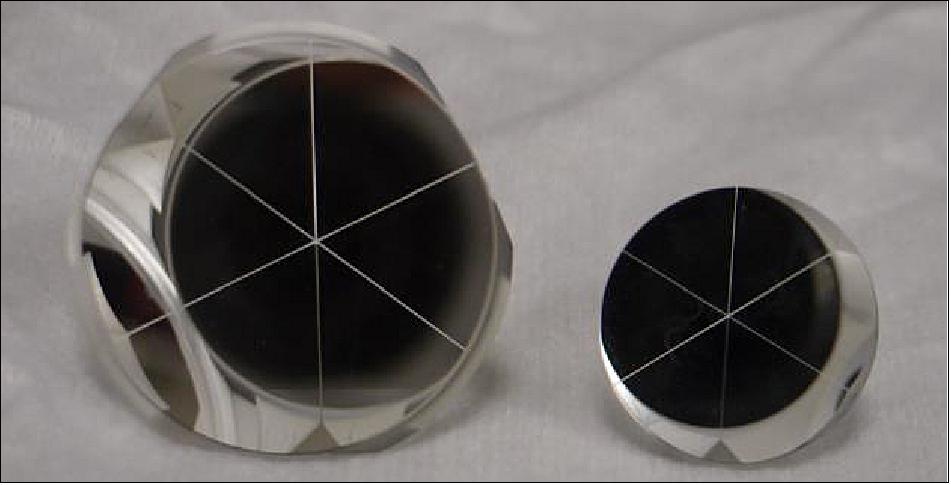
Cube Corner Reflectors
LAGEOS-1, -2 and LARES-1 use 1.5 inch uncoated cube corners with the same floating mount used on the Lunar LRAs. A dihedral angle offset (DAO) was incorporated to provide a beam spread that accounted for the larger velocity aberration in Earth orbit, a phenomenon caused by an observer’s velocity producing apparent motion of an object. The DAO for LAGEOS is 1.25 arcseconds and 1.5 arcseconds for LARES-1 (tolerance of ±0.5 arcseconds), the latter being larger due to LARES-1 being in a lower Earth orbit. However, the DAO creates a messy diffraction pattern and an asymmetry when linear polarisation is used in an uncoated retroreflector, as well as large thermal gradients due to the CCR’s long optical path.
For LARES-2’s CCRs, the size was reduced to one inch instead of adding a DAO, which eliminated the problems created prior, as well as providing one-millimetre accuracy, improved thermal stability and a consistent cross section. Removing the DAO also eliminated the polarisation asymmetry, as well as made tracking the satellite easier since the signal is consistent and independent of the polarisation angle. The diffraction pattern produced by a circular CCR with perfect back reflecting faces is an Airy pattern, shown in Figure 2 with the relationship between velocity aberration and CCR cross section. 28) 29)
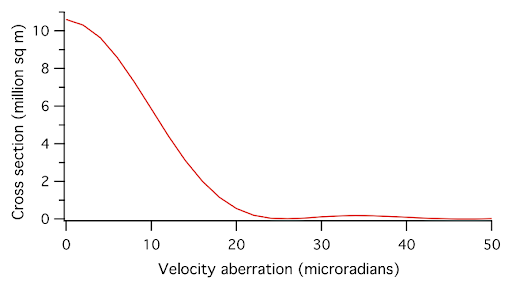
The first ring of the Airy pattern is weak unless a DAO is used. The polarisation effects caused by total internal reflection (TIR) in an uncoated CCR reduces the intensity of the central peak of the Airy pattern by approximately a factor of four, and produces a ring of six peaks, shown in Figure 3.

These peaks in the diffraction pattern eliminate the requirement for a DAO. The pattern can be circularised by orienting the CCRs to fill the gaps between the pattern’s maxima.
The CCR cross section is averaged around a circle at each velocity aberration due to the diffraction pattern having a circular asymmetry. For a satellite orbiting at an altitude of 6,000 km with a DAO of between 30 and 40 microradians the CCR cross section is relatively unaffected. This result is beneficial, since unintentional offsets can be introduced in manufacture. As well as making the satellite easier to track, elimination of the polarisation asymmetry in the CCR cross section also removes a large range correction bias. The ideal CCR has the most uniform range correction and highest cross section per unit reflecting area. The cross section per unit area has a maximum at 1.1 inches, and the smallest change in range correction versus velocity aberration occurs at 1.0 inches. Since the losses due to cross section are minimal, 1.0 inch CCRs were chosen. 30)
Other factors contributing to the choice of COTS CCRs included the good quality of the surface finish, the acceptable dihedral angle and the good quality (grade) of the glass. The other considerations are the good quality of the surface finish, the acceptable dihedral angle and the good quality (grade) of the glass. Concerning the surface quality tolerances for LAGEOS and LARES CCRs they are: 1/10 wavelength for the three back faces and 1/8 wavelength for the front face and ¼ exiting wavefront. The quality assessment was performed through the experimental measurement of the absolute cross section of a lot of 10 CCRs.
The result was quite good since we obtained an average cross-section of 0.36 x 106 m2 when 0.49 x 106 m2 is the theoretical cross-section of a perfect 1-inch in diameter CCR. It has to be considered that in the case of LAGEOS the theoretical vs experimental loss in optical cross-section is about 50%, while we obtained a reduction of only about 26% for this new solution. The DAO measured experimentally by Zeiss, using a Zygo interferometer, showed that seven out of ten CCRs are good. The cost of COTS CCRs is about one order of magnitude less than custom-made CCRs, thus the elimination rate of the COTS CCRs does not constitute a problem. Other tests in thermally controlled environment such as those performed on LARES and CHAMP components are planned. 11) 12) 13)
Materials
The main scientific requirement for the design of LARES and LARES-2 is the density of the alloy because it directly affects the surface-to-mass ratio that in turn is proportional to the effects that non gravitational surface perturbations will produce to the orbital motion of the satellite. During the preliminary design the density of the alloy was chosen close to 10,000 kg/m3. The first idea was to work on a custom alloy to better fit the scientific and engineering requirement chosen for the satellite. We started with copper, cobalt and nickel alloys with which we could have obtained densities of 9,870 kg/m3, 9,900 kg/m3, 9,860 kg/m3, respectively. The percentage of the main metal in the alloys is of 62%, 45% and 74%, respectively. Since the densities of those metals are all around 8,900 kg/m3 it was required the addition of higher density materials, so that in the copper alloy it was decided to include 8% W, 9% Ag, 5% Pb; in the cobalt alloy 13% W; in the nickel alloy 5% Mo and 11 W. This high value of density was indeed optimistic because at the beginning of the development phase, we were relying on a single payload launch.
Later on, ESA responsible of the qualification launch of VEGA C, decided to put on board of the maiden flight educational satellites (CubeSats) for a total mass of about 50 kg. Consequently, we needed to reduce the mass allocated to LARES-2 that in turn brought the density down to about 9,000 kg/m3. In addition the closeness of the foreseen launch date did not give enough time to produce a new alloy fully qualified for space and the only standard one with that density compatible with all the requirements was the Haynes 242, a nickel-based superalloy. Unfortunately, the procuring time for a large block of Haynes 242 was not compatible with the launch date and another readily available nickel alloy, Inconel 718, was selected (see Table 2 for main characteristics).
Alloy | Density (kg/m3) | Yield (MPa) | E (GPa) | Hardness (HRC) | Composition |
Haynes 242 (aged) | 9050 | 1031 | 220-230 | 32 | 65% (balance) Ni, 25% Mo, 8% Cr, 2% max Fe, 1% max Co |
Inconel 718 | 8190 | 1034 | 195-200 | >33.4 | 50%-55% Ni, 17%-21% Cr, 4.75%-5.5% Nb, 2.8%-3.3% Mo, 0.65%-1.15% Ti, 1% max Co, balance: Fe |
Separation System
The separation system interfaces are strictly derived from the one of LARES. In particular the shape, tolerances and materials of the pin are exactly the same as in LARES, while only shape and tolerances of the four hemispherical cavities are equal to the one of LARES, being the satellite material different. In Figure 2 we show a sketch of LARES 2. The separation system shown in the picture is the one used for LARES. The design of the separation system has changed but the four brackets are essentially the same. Also the pushing mechanism is essentially the same being constituted, as for LARES, by two interfaces, one made of a segmented ring supporting all the preload at the south pole of the satellite of about 140000 N (preliminary design) and another one made of smaller contact surfaces supporting the pressure exerted by the pushing spring (about 2500 N). As in the case of LARES the spring force is slightly below the weight of the satellite to avoid accidental ejection in case of unwanted actuation of the mechanism while on the ground. Vibration tests, similar to those performed on LARES satellite will be performed 14) also on LARES-2 to verify that the pre-load does not relax. 15)
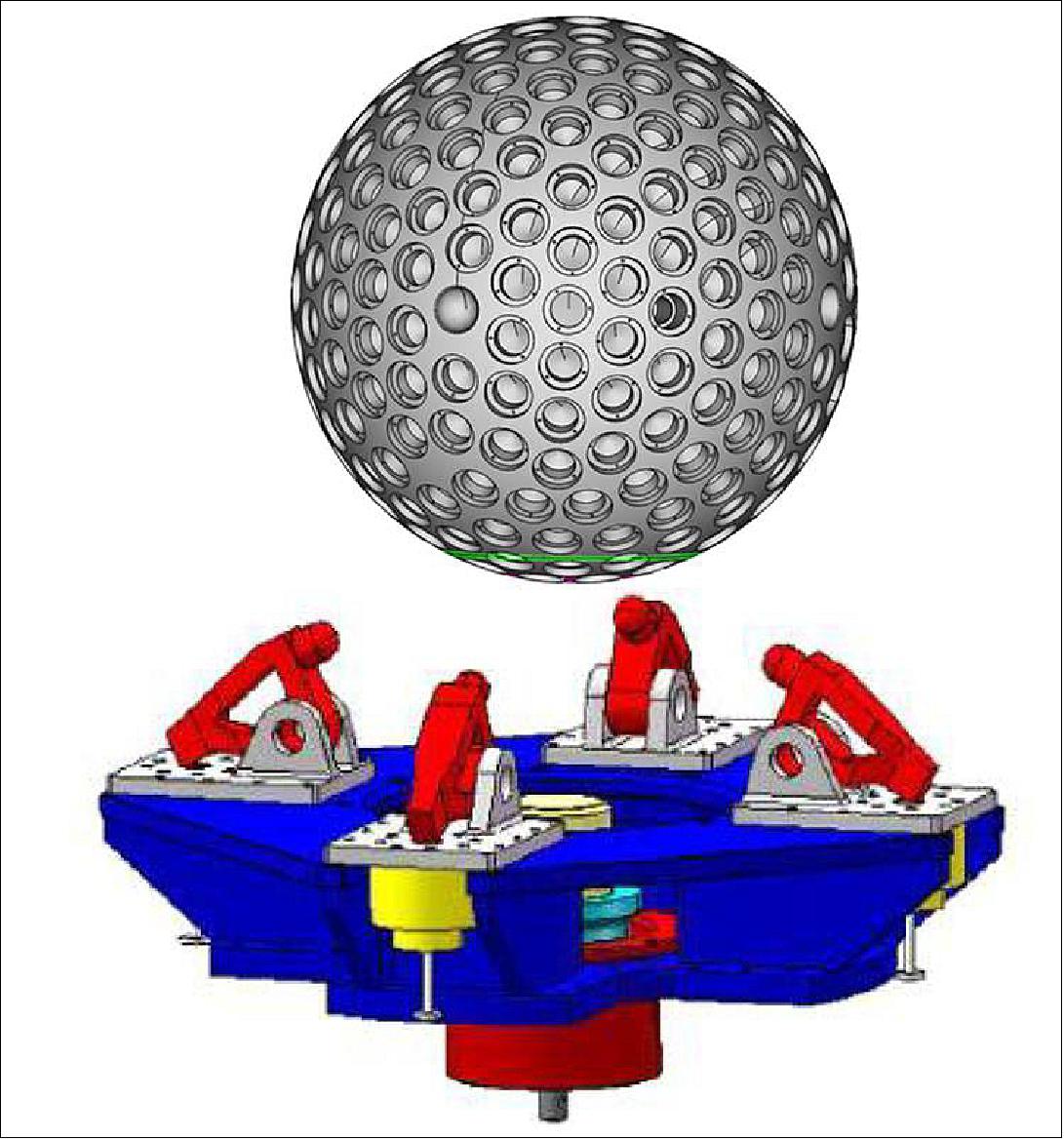
The mechanical characteristics of the material are imposed by the high preload that the separation system exert on the satellite at the four hemispherical cavities. These are: elastic modulus higher than 200 GPa, yield greater than 500 MPa and hardness HRC larger than 28. Table 1 shows that both alloys fulfil the mechanical requirement. The Inconel alloy has a value of Young modulus at the limit, however this requirement is not so strict, indeed the value of the Young modulus and of the yield are coupled in the sense that a higher modulus will induce a higher stress at the contact surfaces according to Hertz theory. One of the alloys considered earlier in the design phase was a copper alloy which had a Young modulus of about 130 GPa with a corresponding value of admissible yield of 400 MPa (Figure 3).
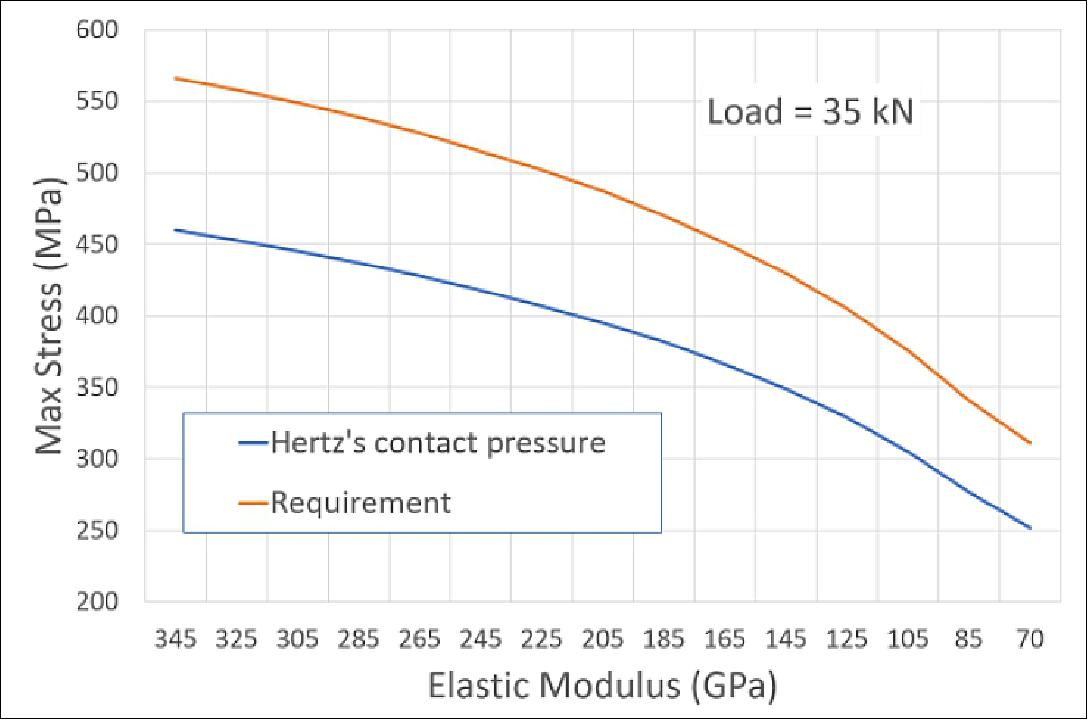
Contribution of LARES-2 to Space Geodesy
The extremely high accuracy of SLR allows the highly accurate determination of the center of mass of the Earth that defines the origin of the ITRF (Ref. 15). 16) 17) The other ITRF attribute that SLR contributes to its definition is the scale, which is shared in equal parts with the astrometric technique of VLBI. 18) Among the many spherical geodetic laser-ranged satellites the two LAGEOS have been used primarily for this purpose, with a small contribution from the two Etalon satellites. However, the LAGEOS satellites were designed in the early ‘70s for cm-level accuracy, which was adequate at the time. Only recently, the LARES satellite has been added to the LAGEOS ones providing an improvement of up to about 20% in the accuracy in the ITRF origin, 19) but still not sufficient for the 1 mm and 0.1 mm/y accuracy and stability required today. 20)
The importance of an accurate ITRF frame can be appreciated considering that all the GNSS orbits are refer to it. The ITRF is recognized by the United Nations, as the "Global Geodetic Reference Frame (GGRF)". With the recent resolution A/RES/69/266 [23],21) UN recommends the use of this reference frame as the standard for all applications. Even with the addition of LARES, the number of geodetic spherical satellites is much smaller with respect to the ones of GNSS. Future availability of LARES-like satellites will allow an increased number of tracking opportunities at any site, several times per day.
The realization and launch of LARES 2 will be an opportunity to expand the SLR Constellation thus allowing to further improve the accuracy in the ITRF. At the same time we take the opportunity to improve considerably the design of LARES 2 in comparison to LARES and the two LAGEOS, ensuring that this will be indeed a mm-level target, and improving its data by an order of magnitude even with the present SLR ground network. A comparison of station site position and EOP (Earth Orientation Parameters), obtained with and without LARES, using the data in the interval 2012-2014 only, indicates an improvement of 17 % and 21 %, respectively.22) The addition of more LARES-class satellites and in particular of LARES 2, will significantly improve the EOP, more than what can be simply estimated statistically (square root law), indeed a more even distribution of laser targets will enhance the geometry of the problem. The improvement of the SLR space segment will contribute to also enhance other terrestrial geophysical parameter measurement. Among those we mention: the terrestrial tides, the secular evolution of the low degree zonal harmonics, and the Earth elastic properties.
In summary, the LARES-2 satellite will support fundamental tests of General Relativity and fundamental physics. In particular it will measure frame-dragging with an unprecedented accuracy of about 2 x 10-3. Frame-dragging is a fascinating prediction of General Relativity. LARES-2 will achieve other measurements of fundamental physics such as the test of the equivalence principle at a range of about 12,300 km. Today, physics has to face deep Nature mysteries such as the accelerated expansion of the universe, dark energy and dark matter, and thus LARES-2 will be a fundamental tool to test alternative theories of gravitation versus General Relativity. The only way to compute the required precise orbits is SLR and the same data will also support a wealth of geodetic products, most notably the ITRF, monitoring of mass redistribution in the Earth System and its center of mass variability, determination of EOP parameters and long wavelength components of Earth's gravitational field.
Parameter | LAGEOS | LARES | LARES-2 (design values) |
Mass (kg) | 406.96 | 386 | 295 |
Radius (mm) | 300 | 182 | 212 |
No of CCRs (Cube Corner Reflectors) | 426 | 92 | 303 |
Mass-to-surface ratio relative to LAGEOS | 1 | 2.6 | 1.5 |
Computed optical cross-section (106 m2) | 15 | 3.3 | 3.92 |
Measured optical cross-section (106 m2) | 7 | 2 | 2.7 |
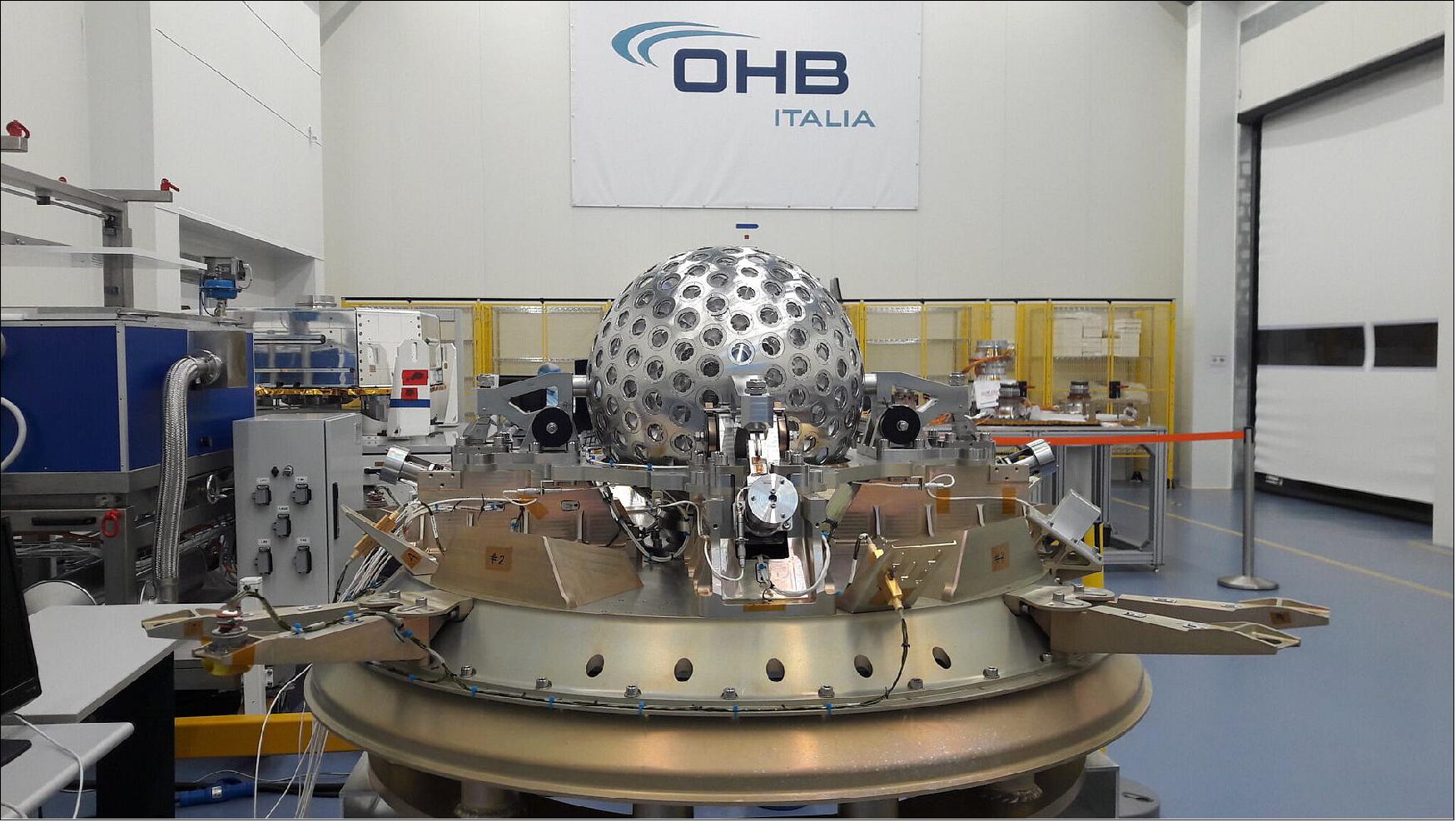
Launch
LARES-2 of ASI (Italian Space Agency), a sphere with a diameter of 424 mm, was launched on 13 July 2022 on the inaugural flight of Vega-C, a four-stage vehicle. Flight VV21 lifted off from Europe's Spaceport in French Guiana at 15:13 CEST (13:13 UTC) on 13 July 2022 (10:13 local time). This mission of Arianespace lasted about 2 hours and 15 minutes from lift-off to release of final payload and final burn of the AVUM+ upper stage engine. 24) 25)
The total payload mass at liftoff was approximately 474 kg: 296 kg for LARES-2, with the remainder being the six CubeSats, payload adapters and carrying structures.
Orbit of LARES-2: Circular MEO (Medium Earth Orbit) with an altitude of 5893 km, eccentricity of 0-0.0025, inclination of 70.16º.
CubeSat Name | CubeSat Provider/Operator | Orbit | Function |
Alpha, 1U CubeSat | NPC Spacemind, Italy | MEO (~5900 km) | Technology demonstration |
AstroBio CubeSat (ABCS), 3U | Sapienza, University of Rome, Italy | MEO (~5900 km) | Immunoassay research |
CELESTA (ROBUSTA 1D), 1U | CERN/University of Montpellier | LEO (~ 500 km) | Technology demonstration |
GreenCube, 3U CubeSat | Sapienza, University of Rome | LEO (~ 500 km) | Space farming |
MTCube-2 (ROBUSTA 1F) | University of Montpellier, France | LEO (~ 500 km) | Technology demonstration |
Trisat-R, 3U CubeSat | University of Maribor, Slovenia | LEO (~ 5900 km) | Technology demonstration |
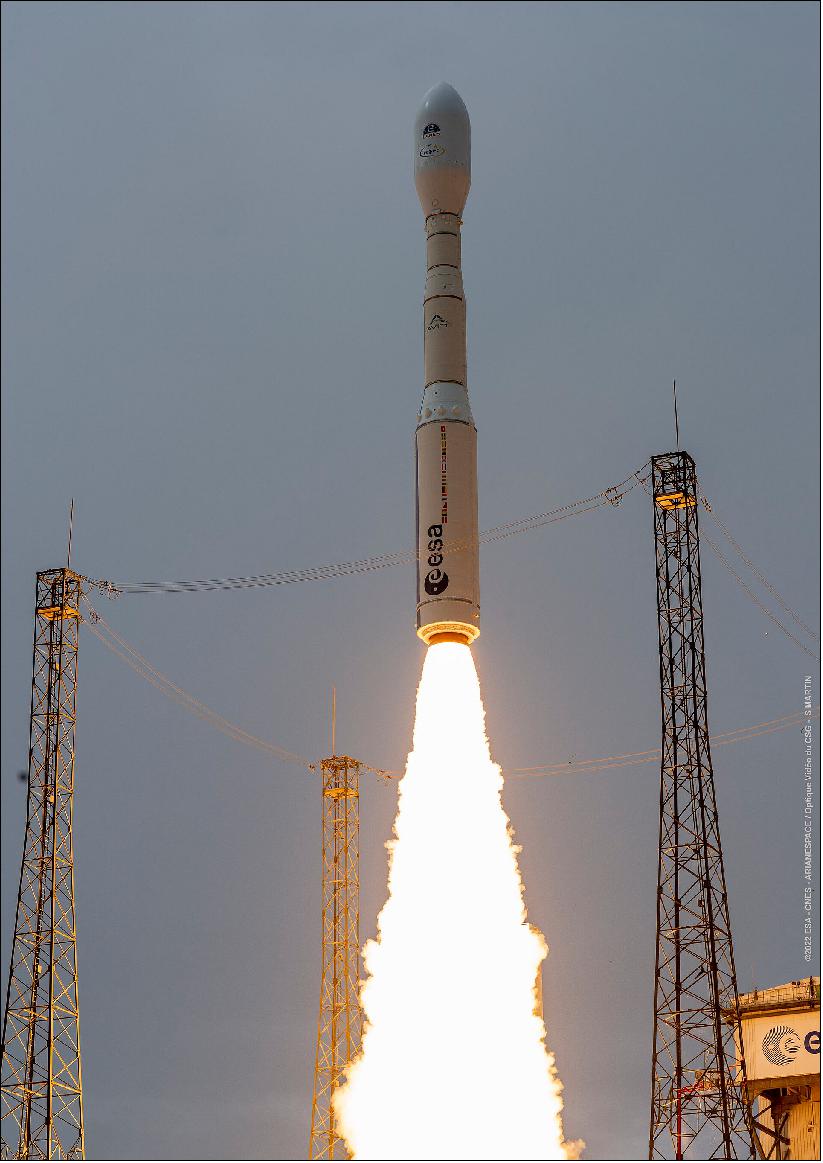
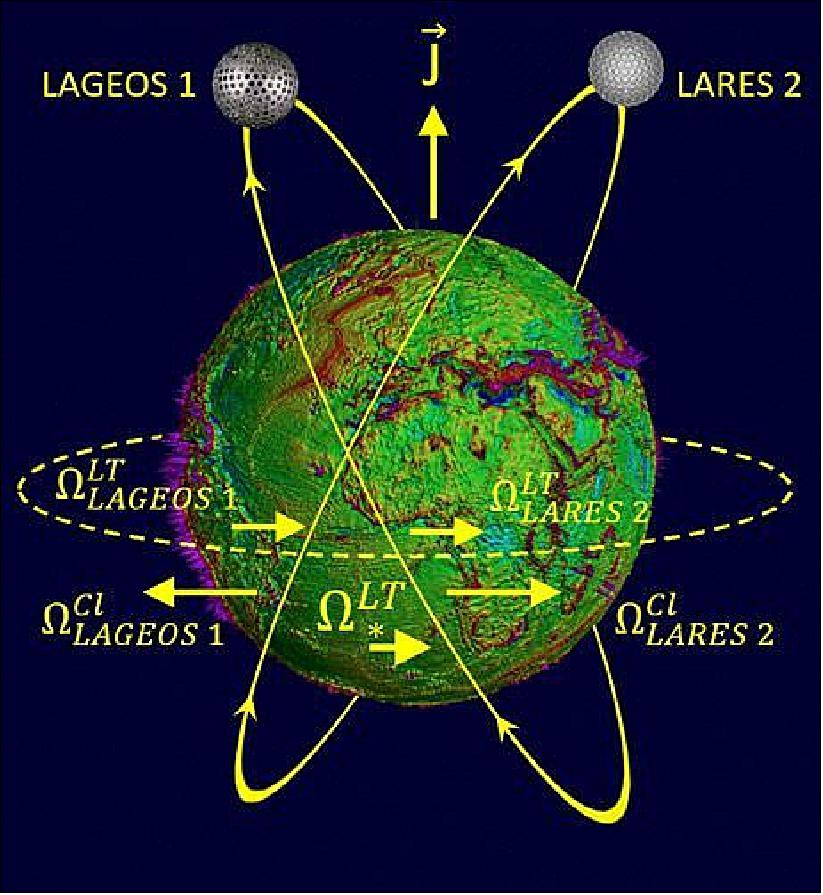
References
1) Ignazio Ciufolini, Antonio Paolozzi, Erricos C. Pavlis, Claudio Paris, Giampiero Sindoni, "LARES 2 an approved mission for testing general relativity," Proceedings of the 70th IAC (International Astronautical Congress), Washington DC, USA, 21-25 October 2019, paper: IAC-19-A2.1.4, URL: https://iafastro.directory/iac/proceedings/IAC-19/IAC-19/A2/1/manuscripts/IAC-19,A2,1,4,x53300.pdf
2) A. Paolozzi,I. Ciufolini, G. Sindoni, C. Paris, "The LARES 2 satellite: new challenges for design and ground test," Aerotecnica Missili & Spazio, Volume 97, Issue 3, pp: 135-144, July 2018, https://doi.org/10.1007/BF03404767
3) Ignazio Ciufolini, Richard Matzner, Vahe Gurzadyan, Roger Penrose, "A new laser-ranged satellite for General Relativity and space geodesy: III. De Sitter effect and the LARES 2 space experiment," The European Physical Journal C, 1 December 2017, Vol. 77:819, https://doi.org/10.1140/epjc/s10052-017-5339-y, URL: https://link.springer.com/content/pdf/10.1140%2Fepjc%2Fs10052-017-5339-y.pdf
4) Ignazio Ciufolini, Antonio Paolozzi, Erricos C. Pavlis, Giampiero Sindoni, John Ries, Richard Matzner, Rolf Koenig, Claudio Paris, Vahe Gurzadyan & Roger Penrose, "An improved test of the general relativistic effect of frame-dragging using the LARES and LAGEOS satellites," The European Physical Journal C, Volume 79, Article number: 872 (2019), Published: 23 October 2019, https://doi.org/10.1140/epjc/s10052-019-7386-z, URL: https://link.springer.com/content/pdf/10.1140/epjc/s10052-019-7386-z.pdf
5) Ignazio Ciufolini, Richard Matzner, Antonio Paolozzi, Erricos C. Pavlis, Giampiero Sindoni, John Ries, Vahe Gurzadyan & Rolf Koenig, "Satellite Laser-Ranging as a Probe of Fundamental Physics," Nature Scientific Reports, Vol. 9, Article number: 15881, Published: 04 November 2019, https://doi.org/10.1038/s41598-019-52183-9, URL: https://www.nature.com/articles/s41598-019-52183-9.pdf
6) Erricos C. Pavlis, Antonio Paolozzi, Giampiero Sindoni, Ignazio Ciufolini, "Contribution of LARES and geodetic satellites on environmental monitoring," 2015 IEEE 15th International Conference on Environment and Electrical Engineering (EEEIC), 10-13 June 2015, Rome, Italy
7) Ignazio Ciufolini, Antonio Paolozzi, Erricos C. Pavlis, Rolf Koenig, John Ries, Vahe Gurzadyan, Richard Matzner, Roger Penrose, Giampiero Sindoni, Claudio Paris, Harutyun Khachatryan & Sergey Mirzoyan, "A test of general relativity using the LARES and LAGEOS satellites and a GRACE Earth gravity model," European Physical Journal C, Vol. 76, Article No 120, https://doi.org/10.1140/epjc/s10052-016-3961-8, Published: 04 March 2016, URL: https://link.springer.com/content/pdf/10.1140/epjc/s10052-016-3961-8.pdf
8) Ignazio Ciufolini, Antonio Paolozzi, Erricos C. Pavlis, Giampiero Sindoni, John Ries, Richard Matzner, Rolf Koenig, Claudio Paris, Vahe Gurzadyan & Roger Penrose, "An improved test of the general relativistic effect of frame-dragging using the LARES and LAGEOS satellites," The European Physical Journal C, volume 79, Article number: 872, https://doi.org/10.1140/epjc/s10052-019-7386-z, Published: 23 October 2019, URL: https://link.springer.com/content/pdf/10.1140/epjc/s10052-019-7386-z.pdf
9) Ignazio Ciufolini, Richard Matzner, Antonio Paolozzi, Erricos C. Pavlis, Giampiero Sindoni, John Ries, Vahe Gurzadyan & Rolf Koenig, "Satellite Laser-Ranging as a Probe of Fundamental Physics," Scientific Reports, Volume 9, 15881, https://doi.org/10.1038/s41598-019-52183-9, Published, 04 November 2019, URL: https://www.nature.com/articles/s41598-019-52183-9.pdf
10) Ignazio Ciufolini, Antonio Paolozzi, Claudio Paris, Giampiero Sindoni, "The LARES satellite and its minimization of the thermal forces," 2014 IEEE Metrology for Aerospace (MetroAeroSpace), 29-30 May 2014, Benevento, Italy, URL: https://web.archive.org/web/20221005100505/https://ieeexplore.ieee.org/document/6865938
11) C. Paris, R. Neubert, "Tests of LARES and CHAMP cube corner reflectors in simulated space environment," IEEE Aerospace Conference, Big Sky, MT, USA, 7-14 March 2015, URL: https://web.archive.org/web/20221016233603/https://ieeexplore.ieee.org/document/7119150
12) Antonio Paolozzi, Ignazio Ciufolini, Luigi Schirone,, Isidoro Peroni, Claudio Paris, D. Spano, G. Sindoni, C. Vendittozzi, G. Battalgia, M. Ramiconi, "Tests of LARES Cube Corner Reflectors in simulated space environment," Proceedings of the 61st IAC (International Astronautical Congress), Prague, Czech Republic, Sept. 27-Oct. 1, 2010, IAC-10.C2.6.11
13) A. Paolozzi, I. Ciufolini, C. Paris, G. Battaglia, N. Reinhart, "Thermal tests on LARES satellite components," 63rd International Astronautical Congress, Naples, Italy, 1-5 October 2012
14) A. Paolozzi, I. Ciufolini, I. Peroni, C. Paris, M. Ramiconi, F. M. Onorati, L. Acquaroli, "Testing the LARES separation system breadboards", 60th International Astronautical Congress, Daejeon, Republic of Korea, 12-16 October 2009
15) Claudio Paris, "Vibration tests on the preloaded LARES satellite and separation system", Aerospace Science and Technology, Volume 42, April–May 2015, Pages 470-476, https://doi.org/10.1016/j.ast.2015.01.023
16) E. C. Pavlis, "Fortnightly resolution geocenter series: a combined analysis of LAGEOS 1 and 2 SLR data (1993–96)", IERS technical note 25, Observatoire de Paris, April 1999, URL: https://www.iers.org/SharedDocs/Publikationen/EN/IERS/Publications/tn/TechnNote25/tn25_075.pdf;jsessionid=2FB97FDC4596CCDBE443D66D263AA3B1.live1?__blob=publicationFile&v=1
17) E. C. Pavlis, M. Kuźmicz-Cieślak, "Geocenter motion: causes and modeling approaches", Proceedings of the 16th International Laser Ranging Workshop, Poznan Poland, 12-17 October 2008, URL: https://cddis.nasa.gov/lw16/docs/papers/sci_2_Pavlis_p.pdf
18) Zuheir Altamimi, Paul Rebischung, Laurent Métivier, Xavier Collilieux, "ITRF2014: A new release of the International Terrestrial Reference Frame modeling nonlinear station motions," Journal of Geophysical Research-Solid Earth, First published: 18 July 2016, https://agupubs.onlinelibrary.wiley.com/doi/full/10.1002/2016JB013098, URL: https://agupubs.onlinelibrary.wiley.com/doi/epdf/10.1002/2016JB013098
19) Mathis Bloßfeld, Sergei Rudenko, Alexander Kehm, Natalia Panafidina, Horst Müller, Detlef Angermann, Urs Hugentobler & Manuela Seitz," Consistent estimation of geodetic parameters from SLR satellite constellation measurements," Journal of Geodesy, Volume 92, pages1003–1021(2018), Published: 14 July 2018, https://link.springer.com/article/10.1007/s00190-018-1166-7
20) Hans-Peter Plag, Michael Pearlman, "Global Geodetic Observing System -Meeting the Requirements of a Global Society on a Changing Planet in 2020," Springer Verlag, 2009
21) United Nations General Assembly, "A global geodetic reference frame for sustainable development," Resolution No. A/RES/69/266, 26 February 2015, http://ggim.un.org/knowledgebase/KnowledgebaseCategory37.aspx
22) E. C. Pavlis, A. Paolozzi, I. Ciufolini, C. Paris, G. Sindoni and A. Gabrielli, "Use of LARES Satellite Data for Earth Science," 23rd Conference of the Italian Association of Aeronautics and Astronautics AIDAA2015, Torino, Italy, 17-19 November 2015
23) "LARES 2 mission," URL: http://www.lares-mission.com/LARES_2.asp
24) "Vega-C successfully completes inaugural flight," ESA Enabling & Support, 13 July 2022, URL: https://www.esa.int/Enabling_Support/Space_Transportation/Vega/Vega-C_successfully_completes_inaugural_flight
25) "Following the success of the inaugural flight, Arianespace to start operations of Vega C with seven launchers already sold," Arianespace Press Release, 13 July 2022, URL: https://www.arianespace.com/press-release/following-the-success-of-the-inaugural-flight-arianespace-to-start-operations-of-vega-c-with-seven-launchers-already-sold/
26) "Highlights of the inaugural Vega-C launch," ESA Enabling & Support, 13 July 2022, URL: https://www.esa.int/ESA_Multimedia/Videos/2022/07/Highlights_of_the_inaugural_Vega-C_launch
27) A. Paolozzi, I. Ciufolini, G. Sindoni, C. Paris, "LARES 2 satellite and Mission Description," Aerotecnica Missili & Spazio, The Journal of Aerospace Science, Technology and Systems, Vol. 97, No.3 July-September 2018, pp 135-144.
28) David A. Arnold, "Lares-2, the “Next Generation” Lageos," Smithsonian Astrophysical Observatory, URL: http://davidarnoldresearch.org/Lares-2.pdf
29) David A. Arnold, "Thermal-optical design of a geodetic satellite for one millimeter accuracy," Advances in Space Research, Volume 65, Issue 10, 2020, Pages 2276-2289, URL: https://www.sciencedirect.com/science/article/pii/S0273117720300491
30) David A. Arnold, "Transfer Function of the LARES Retroreflector Array," Smithsonian Astrophysical Observatory, URL: https://ilrs.gsfc.nasa.gov/docs/2015/Arnold_LaresFinal.pdf
The information compiled and edited in this article was provided by Herbert J. Kramer from his documentation of: "Observation of the Earth and Its Environment: Survey of Missions and Sensors" (Springer Verlag) as well as many other sources after the publication of the 4th edition in 2002. - Comments and corrections to this article are always welcome for further updates (eoportal@symbios.space).